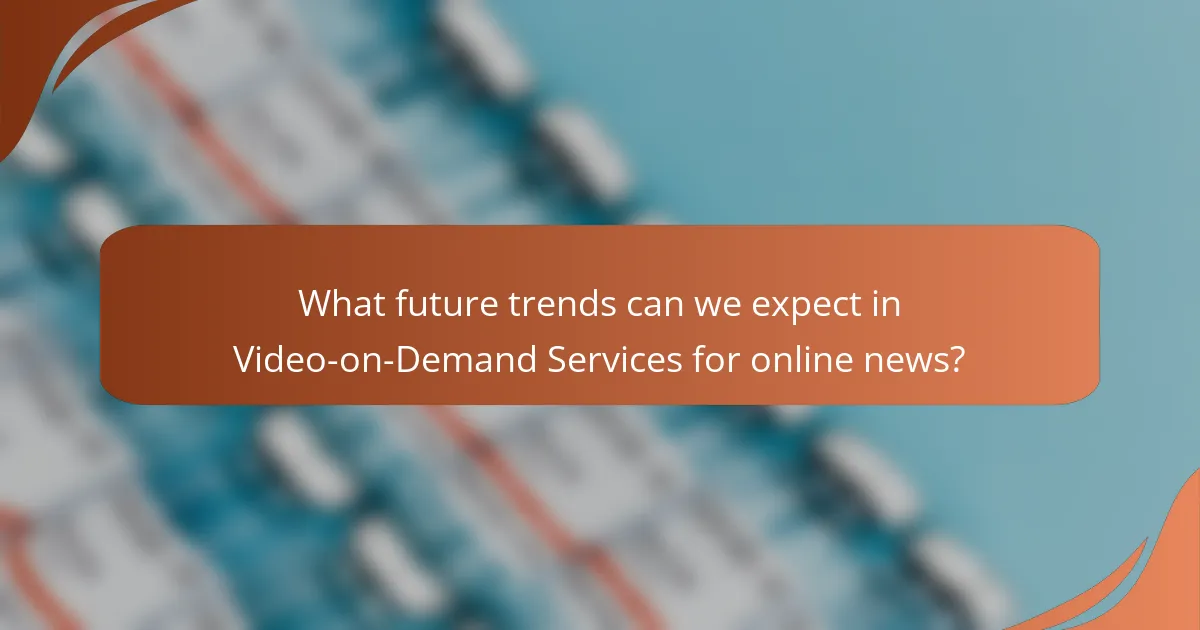Video-on-Demand (VOD) services for online news are platforms that enable users to access news content at their convenience, offering a library of news videos, documentaries, and live updates. These services utilize algorithms and editorial oversight to curate content, ensuring personalized recommendations that enhance user engagement. The article explores key aspects of VOD services, including revenue models, audience preferences, and content curation strategies. It also examines future trends such as increased personalization, AI integration, and enhanced interactivity, reflecting the evolving landscape of media consumption. Insights from eMarketer highlight the significant rise in VOD consumption, indicating a shift in audience behavior towards on-demand news access.

What are Video-on-Demand Services for Online News?
Video-on-Demand (VOD) services for online news are platforms that allow users to access news content at their convenience. These services provide a library of news videos that can be streamed anytime. Users can watch news segments, documentaries, and live updates on demand. VOD services often feature content from various news outlets. They cater to diverse audience preferences by offering personalized recommendations. This flexibility enhances user engagement and satisfaction. According to a report by eMarketer, VOD consumption has increased significantly in recent years, indicating a shift in how audiences prefer to consume news.
How do Video-on-Demand Services differ from traditional news media?
Video-on-Demand services differ from traditional news media primarily in their delivery and consumption methods. Video-on-Demand allows viewers to watch content at their convenience, unlike traditional news media, which follows a scheduled broadcast format. This flexibility caters to modern audience preferences for on-demand access.
Moreover, Video-on-Demand platforms often provide a wider variety of content, including niche topics not typically covered by traditional media. Traditional news media usually focuses on breaking news and well-established stories, limiting viewer choice.
Additionally, Video-on-Demand services often incorporate user-generated content and interactive features, enhancing audience engagement. Traditional news media typically relies on professionally produced content with limited viewer interaction.
The rise of Video-on-Demand reflects changing consumer habits, with a 2021 report indicating that 82% of U.S. households subscribed to at least one streaming service. This trend highlights the growing preference for on-demand viewing over traditional news consumption.
What are the key features of Video-on-Demand Services for news?
Key features of Video-on-Demand Services for news include accessibility, flexibility, and personalization. Accessibility allows users to watch news content anytime and anywhere. Flexibility enables viewers to choose specific news segments rather than watching full broadcasts. Personalization tailors content recommendations based on user preferences and viewing history.
These services often provide on-demand access to live news broadcasts and recorded segments. Many platforms feature user-friendly interfaces for easy navigation. High-definition video quality enhances the viewing experience. Subscription models often include ad-free options, improving user satisfaction.
According to a report by eMarketer, 63% of U.S. adults prefer on-demand news content, highlighting the growing trend in audience preferences. The combination of these features meets the evolving demands of viewers in a digital landscape.
How do these services enhance user experience compared to live broadcasts?
Video-on-Demand services enhance user experience compared to live broadcasts by offering flexibility and control over content consumption. Users can choose what to watch and when, allowing for personalized viewing schedules. This eliminates the need to adhere to a fixed broadcast schedule. Additionally, these services often provide on-demand access to a vast library of content, enabling users to revisit important news stories or topics of interest.
The ability to pause, rewind, or fast-forward enhances engagement and comprehension. Research indicates that 70% of viewers prefer watching news on-demand for these reasons. Furthermore, video-on-demand platforms often feature curated content based on user preferences, which improves content relevance. This targeted curation leads to higher viewer satisfaction and retention rates.
What are the primary revenue models for Video-on-Demand Services?
The primary revenue models for Video-on-Demand (VOD) services include subscription-based, ad-supported, transaction-based, and hybrid models. Subscription-based models charge users a recurring fee for access to content. This model is popular among platforms like Netflix and Hulu. Ad-supported models provide free access to content while generating revenue through advertisements. Platforms such as YouTube and Tubi utilize this model effectively. Transaction-based models require users to pay for individual pieces of content, such as renting or purchasing movies. This approach is seen on platforms like Amazon Prime Video. Hybrid models combine elements of subscription, ad-supported, and transaction-based models. Services like Disney+ and HBO Max incorporate multiple revenue streams. Each model caters to different audience preferences and consumption behaviors.
How do subscription-based models work in the context of online news?
Subscription-based models in online news provide users access to content for a recurring fee. These models often include monthly or annual subscriptions. Users typically receive premium articles, ad-free experiences, or exclusive content. News organizations benefit from predictable revenue streams. This model allows for investment in quality journalism. According to the Pew Research Center, 69% of U.S. adults reported paying for news in some form as of 2021. Subscription models also encourage reader loyalty and engagement. This approach contrasts with ad-supported models that rely on traffic and clicks.
What role do advertising and sponsorships play in revenue generation?
Advertising and sponsorships are crucial for revenue generation in video-on-demand services. They provide a significant source of income through targeted promotions and brand partnerships. Advertisers pay to reach specific audiences, enhancing their brand visibility. Sponsorships often involve funding in exchange for brand integration within content. This creates a mutually beneficial relationship between content creators and brands. According to eMarketer, digital ad spending in the U.S. is projected to reach $200 billion by 2023. This growth underscores the importance of advertising in the digital landscape. Additionally, successful sponsorships can lead to long-term partnerships, further stabilizing revenue streams.
How do pay-per-view models function in online news services?
Pay-per-view models in online news services allow users to access specific articles or videos for a fee. Users typically pay for individual pieces of content rather than subscribing to a full service. This model generates revenue directly from consumers who are interested in specific topics.
News organizations implement this model to monetize high-quality journalism. They often offer premium content that is not available for free. By providing exclusive insights or in-depth analysis, they attract users willing to pay.
This approach can be supported by data showing increased engagement with premium content. For example, a study by the Reuters Institute indicates that consumers are more likely to pay for news they perceive as valuable.
What audience preferences influence Video-on-Demand Services for news?
Audience preferences that influence Video-on-Demand services for news include convenience, content variety, and personalization. Viewers prefer on-demand access to news content that fits their schedules. They seek diverse topics, including local, national, and international news. Personalization features, such as tailored recommendations, enhance user engagement. Research indicates that 67% of users favor platforms that offer customized content. Additionally, quality and credibility of news sources significantly impact audience choice. Fast-loading videos and user-friendly interfaces further attract viewers. Overall, these preferences shape the offerings of Video-on-Demand services in the news sector.
How do demographics affect content consumption on these platforms?
Demographics significantly affect content consumption on video-on-demand platforms. Different age groups exhibit varying preferences for content types. For instance, younger audiences tend to favor short-form videos and interactive content. In contrast, older demographics often prefer longer, more in-depth programming. Gender also plays a role; studies show that women are more likely to consume lifestyle and health-related content, while men often gravitate towards sports and technology. Additionally, cultural background influences content choices, with diverse groups seeking culturally relevant programming. This data indicates that understanding demographic factors is crucial for content creators and marketers aiming to optimize engagement on these platforms.
What types of news content are most popular among viewers?
Breaking news is the most popular type of news content among viewers. This category includes urgent updates on significant events, such as natural disasters or political developments. Viewers prefer breaking news due to its immediacy and relevance. According to a Pew Research Center study, 70% of adults in the U.S. report that they often consume breaking news. Another popular type is investigative journalism, which dives deep into issues and uncovers hidden truths. This form of content attracts viewers seeking in-depth analysis. Additionally, human interest stories resonate well with audiences, as they connect emotionally and highlight personal experiences. Overall, the combination of breaking news, investigative pieces, and human interest stories forms the core of viewer preferences in news content.
How do user engagement and feedback shape content offerings?
User engagement and feedback significantly shape content offerings in video-on-demand services. High levels of engagement indicate viewer preferences and interests. Feedback, such as comments and ratings, provides direct insights into audience satisfaction. Services analyze this data to identify popular topics and formats. This analysis informs content creation and curation strategies. For example, platforms may prioritize genres that receive positive feedback. Additionally, user engagement metrics can lead to adjustments in release schedules. Data-driven decisions enhance viewer retention and attract new subscribers. Ultimately, aligning content with user preferences fosters a more satisfying viewing experience.

How is content curated in Video-on-Demand Services for online news?
Content in Video-on-Demand Services for online news is curated through algorithms and editorial oversight. Algorithms analyze user behavior and preferences to recommend relevant content. This data-driven approach personalizes the viewing experience. Editorial teams also select and prioritize news stories based on relevance and timeliness. They ensure a diverse range of topics is covered. User feedback influences future content selections. Various metrics, such as view counts and engagement rates, guide curation decisions. This combination of technology and human insight enhances content relevance and viewer satisfaction.
What strategies are used for effective content curation?
Effective content curation strategies include selecting relevant content, organizing it logically, and providing context. Curators should identify high-quality sources that align with audience interests. They must categorize content to enhance discoverability. Adding personal insights or commentary can increase engagement. Utilizing social media platforms for distribution expands reach. Regularly updating curated content keeps it fresh and relevant. Analytics can guide curators in understanding audience preferences. These strategies collectively enhance the value of curated content for viewers.
How do algorithms influence content recommendations for users?
Algorithms influence content recommendations for users by analyzing their behavior and preferences. They utilize data such as viewing history, search queries, and user interactions. This data is processed to identify patterns and trends. Algorithms then generate personalized content suggestions based on these insights. For example, if a user frequently watches political news, the algorithm will prioritize similar content. Research indicates that personalized recommendations can increase user engagement by up to 70%. This demonstrates the effectiveness of algorithms in enhancing user experience through tailored content.
What role does human curation play alongside automated systems?
Human curation plays a critical role alongside automated systems in video-on-demand services for online news. Automated systems can efficiently gather and analyze vast amounts of data. However, they often lack the nuanced understanding of context that human curators provide. Human curators enhance content selection by applying editorial judgment and understanding audience preferences. They ensure that the curated content aligns with ethical standards and quality benchmarks. Research indicates that audiences value human touch in content curation, leading to increased engagement. For instance, a study by the Pew Research Center found that 64% of users prefer news curated by humans over algorithms. This highlights the importance of human curators in maintaining trust and relevance in online news services. Thus, human curation complements automated systems by adding depth and reliability to content delivery.
What challenges do Video-on-Demand Services face in content curation?
Video-on-Demand Services face several challenges in content curation. One significant challenge is the vast amount of available content. This makes it difficult to select relevant and high-quality material. Another challenge is audience diversity. Different viewers have varying preferences, making it hard to cater to all tastes. Additionally, algorithmic bias can skew recommendations. This can lead to a lack of variety in the content shown to users.
Content licensing issues also complicate curation efforts. Services must navigate complex rights agreements, which can limit available options. Competition among platforms intensifies the challenge. Each service strives to differentiate itself, often leading to content exclusivity deals. Finally, maintaining user engagement is crucial. Services must continually update their offerings to keep viewers interested. These factors collectively create a complex landscape for effective content curation in Video-on-Demand Services.
How do copyright and licensing issues impact content availability?
Copyright and licensing issues significantly restrict content availability. These legal frameworks determine how content can be used, shared, and distributed. Copyright protects the rights of creators, limiting unauthorized use. Licensing agreements specify the terms under which content can be accessed. For instance, platforms may require licenses to stream news footage. Failure to secure these licenses can lead to content removal or legal penalties. Additionally, copyright laws vary by country, complicating international content distribution. This can result in certain content being inaccessible in specific regions. Therefore, copyright and licensing directly influence what content is available to audiences.
What are the implications of misinformation and quality control?
Misinformation negatively impacts the credibility of video-on-demand news services. Quality control measures are essential to ensure accurate information dissemination. The presence of misinformation can lead to audience mistrust and reduced viewership. Studies show that 86% of Americans believe misinformation poses a significant threat to democracy. Quality control helps in maintaining journalistic standards and audience engagement. Effective quality control can mitigate the spread of false information. This is crucial for sustaining revenue models in competitive media landscapes. A lack of quality control can result in long-term damage to a brand’s reputation.

What future trends can we expect in Video-on-Demand Services for online news?
Future trends in Video-on-Demand services for online news include increased personalization, integration of AI, and enhanced interactivity. Personalization will allow viewers to receive tailored news content based on their preferences. AI will play a crucial role in content curation and recommendation systems. Enhanced interactivity will enable users to engage with news stories through features like live polls and Q&A sessions. Additionally, there will be a shift towards subscription-based models as audiences seek ad-free experiences. The demand for high-quality video content will continue to rise, driven by the popularity of streaming platforms. These trends reflect changing audience behaviors and technological advancements in media consumption.
How is technology shaping the evolution of these services?
Technology is significantly shaping the evolution of video-on-demand services for online news. It enhances accessibility for users through various devices like smartphones and smart TVs. Streaming technology allows for real-time content delivery and on-demand viewing. Advanced algorithms enable personalized content recommendations based on user preferences. Data analytics provides insights into audience behavior, informing content creation and curation. The integration of social media facilitates content sharing and engagement among viewers. Additionally, cloud technology supports scalable storage and distribution of vast amounts of video content. These advancements contribute to the growth and adaptation of revenue models in the online news sector.
What innovations are emerging in user interface and experience?
Emerging innovations in user interface and experience include voice user interfaces, augmented reality, and personalized content delivery. Voice user interfaces enhance accessibility and enable hands-free navigation. Augmented reality provides immersive experiences for users, enriching content interaction. Personalized content delivery utilizes algorithms to tailor news feeds based on user preferences. These innovations improve engagement and user satisfaction in video-on-demand services. Research by Nielsen indicates that personalized experiences can increase user retention by up to 30%.
How might viewer preferences change in the coming years?
Viewer preferences are likely to shift towards more personalized and interactive content. As technology advances, audiences will demand tailored news experiences that cater to their specific interests. Data from recent surveys indicates that 70% of viewers prefer content that aligns with their individual preferences. Additionally, the rise of AI-driven recommendations will enhance content curation. This technology can analyze viewer behavior and suggest relevant news articles or videos. Furthermore, younger audiences increasingly favor short-form content, as seen in platforms like TikTok. This trend suggests that traditional long-form news may decline in popularity. Overall, the trajectory points towards a more customized and engaging viewer experience in online news consumption.
What best practices should content creators follow for Video-on-Demand Services?
Content creators should prioritize high-quality content for Video-on-Demand services. Engaging storytelling captures audience attention effectively. Consistent branding helps establish a recognizable identity. Optimizing video for SEO increases discoverability on platforms. Regularly analyzing audience feedback improves future content strategies. Utilizing analytics tools provides insights into viewer behavior. Collaborating with other creators can expand reach and diversify content. Adhering to platform guidelines ensures compliance and prevents penalties.
How can creators effectively engage their audience through content?
Creators can effectively engage their audience through content by delivering relevant and valuable information. Tailoring content to audience interests increases retention and interaction. Utilizing storytelling techniques makes messages more relatable and memorable. Incorporating visuals enhances understanding and keeps viewers’ attention. Engaging in two-way communication fosters community and encourages feedback. Regularly updating content keeps the audience informed and interested. Analyzing audience data helps creators refine strategies for better engagement. Research shows that personalized content can boost engagement rates by up to 50%.
What strategies can enhance the monetization of online news content?
Implementing subscription models can enhance the monetization of online news content. Subscription models provide a steady revenue stream. They encourage loyal readership and create a direct relationship with consumers. Offering tiered subscription plans can cater to different audience segments. Additionally, incorporating paywalls can restrict access to premium content. This strategy can increase perceived value and exclusivity. Advertisements can complement subscription models. Programmatic advertising can maximize revenue through targeted ads. Sponsored content can also be a viable revenue source. Collaborations with brands can create engaging content that benefits both parties. Data analytics can optimize content strategies. Understanding audience preferences leads to tailored offerings. These strategies collectively enhance monetization efforts in online news content.
Video-on-Demand (VOD) services for online news are platforms that provide users with convenient access to a diverse library of news content, including segments, documentaries, and live updates. The article examines the differences between VOD services and traditional news media, highlighting key features such as accessibility, flexibility, and personalization. It also explores various revenue models, including subscription-based and ad-supported options, along with audience preferences that shape content consumption. Additionally, the article discusses the role of algorithms and human curation in content recommendations, as well as the challenges and future trends impacting VOD services in the online news landscape.
